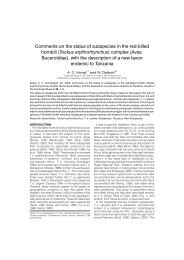EAZA Hornbill Management and Husbandry Guidelines
EAZA Hornbill Management and Husbandry Guidelines
EAZA Hornbill Management and Husbandry Guidelines
Create successful ePaper yourself
Turn your PDF publications into a flip-book with our unique Google optimized e-Paper software.
See Section 6.3 for more details on nest box requirements.<br />
4.8.5 Food tray <strong>and</strong> feeding<br />
Regular h<strong>and</strong>-feeding of hornbills may have a negative effect on pair-bonding between<br />
hornbills, as a h<strong>and</strong>-fed bird could eventually become more interested in the keeper than<br />
in his/her partner (see section 7.1: Human-hornbill interactions).<br />
The food tray should be placed >1.5 m above the ground as foraging on the ground might<br />
give hornbills an insecure feeling. Food trays for ground hornbills Bucorvus spp. can be<br />
placed nearer the ground.<br />
It is preferable for keepers to access food trays from outside a hornbill enclosure as<br />
hornbills can become extremely aggressive to keepers when in breeding condition. A<br />
perch close to the food tray allows the male <strong>and</strong> female to feed each other. If not in public<br />
view, a wide surface around the feed tray can be very useful in keeping food items from<br />
falling to the ground, thus reducing waste <strong>and</strong>/or inadvertent consumption of the substrate<br />
when dropped food items are picked up. Substrate suitability should indeed be considered<br />
in placement of food trays. Mats that can be easily replaced <strong>and</strong> cleaned are a possible<br />
option. If natural substrates are used beneath food trays these need to be low in iron in<br />
case of possible ingestion when the hornbills pick food up from the ground. S<strong>and</strong> is not<br />
digestible <strong>and</strong> is not recommended as it can cause impaction. See also 4.7.2: Floor<br />
(substrate) materials.<br />
Food trays that other birds (wild or captive) might defecate onto should be covered to<br />
avoid disease transmission. Rodent-proof feeders (free st<strong>and</strong>ing, mounted on a pole<br />
encircled by a metal “guard” can help prevent food theft <strong>and</strong> disease spread. See also<br />
Section 3.1.4: Pseudotuberculosis <strong>and</strong> Section 4.7.2: Floor (substrate) materials.<br />
Ideally non-breeding hornbills should be provided with fresh food two times a day (early<br />
morning <strong>and</strong> mid-afternoon), <strong>and</strong> hornbills with chicks at least three times a day.<br />
4.9 Maintenance<br />
Feeding areas should be cleaned every day so that feces <strong>and</strong> old, fallen food are not eaten<br />
by the hornbills. The rest of the enclosure can be cleaned less frequently <strong>and</strong> cleaning<br />
procedures used should minimize disturbance. Strategic placement of food areas <strong>and</strong><br />
perches (not close to walls or above plants) can greatly reduce the amount of cleaning<br />
time needed.<br />
34




